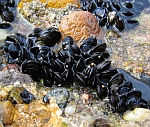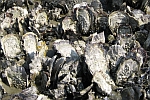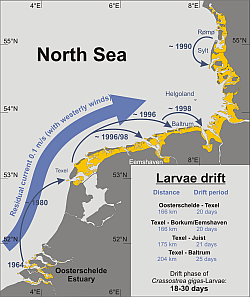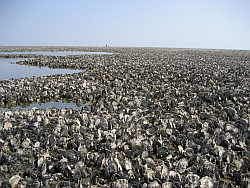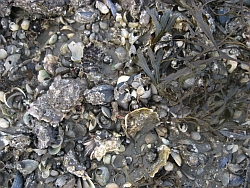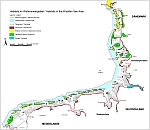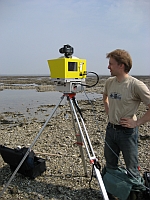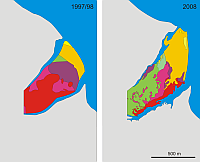4. Invasieve soorten in de oceaan
Casestudy: De Pacific oester in de Noordzee
Blauwe mosselen (Mytilus edulis) vormen belangrijke biologische populaties in de getijdenzone (eulittoraal) van het Waddenzee-ecosysteem. Blauwe mosselbanken zijn belangrijke biogene structuren die als habitat en voedselbron dienen voor een aantal soorten. Ze beïnvloeden de hydrodynamische processen door de stroomsnelheid te verminderen en modder en zand vast te houden.
Sinds het einde van de jaren negentig begint de PPacifische oester (Crassostera gigas) zich vanuit het oosten (Oost-Friesland) te verspreiden naar de Duitse Waddenzee. Tegenwoordig komt de Pacifische oester voor in alle blauwe mosselbanken in de hele Waddenzee, van Nederland in het westen tot Denemarken in het noorden. Sommige mosselbanken herbergen wel 1000 dieren per vierkante meter. De Pacifische oester is dus een uitheemse indringer in de Noordzee.
Ontwikkeling van de populaties blauwe mosselen in de Noordzee
Het gebied van de blauwe mosselbanken in de Waddenzee is de afgelopen decennia drastisch afgenomen. In Nedersaksen, Duitsland, is het gebied van de mosselbanken bijvoorbeeld afgenomen van 50 km2 in 1975 tot 27 km2 in 1989/91. In het voorjaar van 1996 werd het laagste geregistreerde niveau bereikt: er was nog maar 1.7 km2 aan mosselbanken over!
De totale biomassa van blauwe mosselen daalde van 47.000 ton in 1989/91 tot 1.000 ton in 1996. Dit komt neer op een verlies van 60%, terwijl de afname van het oppervlak in dezelfde periode 47% bedroeg.
Na een sterke spatval in de zomer van 1996 nam het totale oppervlak van de mosselbanken toe tot ongeveer 29 km2 (1999)
met een biomassa van 110.000 ton.
(Bron: Nationaal Park Waddenzee van Nedersaksen)
De verspreiding van de Pacifische oester in de Noordzee
In de jaren zestig werd de Pacifische oester naar Nederland gebracht om te worden gekweekt. Men ging ervan uit dat de oester niet in het wild zou paaien vanwege de relatief lage watertemperaturen. De Pacifische oester paste zich echter goed aan en paait zelfs sneller dan de inheemse blauwe mossel. Hij kan tijdens één paaitijd wel 50 tot 100 miljoen eitjes produceren en dit kan meerdere keren per seizoen gebeuren. De larven ontsnappen uit de oesterkwekerijen door transport via kuststromingen. Naast een succesvolle spatval bepalen dus ook de windomstandigheden de verspreiding.
Eind jaren negentig werd de Pacifische oester op verschillende plaatsen op de Duitse eilanden van Oost-Friesland aangetroffen. In 1986 werd hij voor de kweek geïntroduceerd op Sylt, enkele jaren later werden de eerste exemplaren in het wild rond het eiland ontdekt.
Door een goede spatval in 2003 hebben veel oesterbanken zich op veel plaatsen snel ontwikkeld tot solide riffen. Tegenwoordig bevinden zich tot wel 1400 Pacifische oesters op één vierkante meter (de gemiddelde abundantie is 300 individuen per vierkante meter). Jongere oesters nestelen zich bovenop oudere oesters. Tegenwoordig zijn er geen mosselbanken meer zonder oesters.
Hoe gaan blauwe mosselen en Pacifische oesters met elkaar om?
Blauwe mosselen en Pacifische oesters concurreren om voedsel. Beide soorten leven in de getijdenzone (eulittoraal) van de Waddenzee en filteren zwevende deeltjes uit het zeewater. De oester is echter superieur in zijn groeisnelheid: hij kan tot 5 cm per jaar groeien en een lengte van maximaal 30 cm bereiken, meer dan het dubbele van de maximale grootte van de blauwe mossel. Zijn larven bewegen veel sneller dan die van de blauwe mossel, waardoor ze een grotere kans hebben om aan mogelijke vijanden te ontsnappen. De inheemse mossel dient als voedselbron voor vogels, krabben en zeesterren. De invasieve oester heeft geen natuurlijke vijanden in de Noordzee. Hij nestelt zich op mosselbanken en doodt de mosselen tot op zekere hoogte door zich vast te hechten en riffen te bouwen. De Pacifische oester moet dus worden beschouwd als een potentieel risico voor de mosselbanken van de Waddenzee.
Klinkt als een overwinning voor de Pacifische oester?
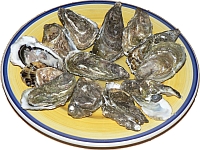
Uiteindelijk kunnen de twee soorten toch redelijk goed met elkaar overweg. Ze kunnen complexe en biodiverse gemeenschappen vormen met algen, alikruiken en een overvloed aan mosselzaad. Tot op heden is er geen bewijs dat de Pacifische oester het uitsterven van de blauwe mossel heeft veroorzaakt of zal veroorzaken.
Een beheerplan voor de blauwe mossel in de Waddenzee
De neerwaartse trend van de blauwe mosselpopulatie tot halverwege de jaren negentig en controversiële discussies in het publiek over de visserij als mogelijke oorzaak van de achteruitgang leidden tot het politieke besluit om een beheersplan voor de blauwe mossel in de Waddenzee op te stellen. De twee belangrijkste stappen waren
- Regulering van de blauwe mosselvisserij door middel van wetgeving, en
- Constante monitoring van mosselbanken.
Als gevolg hiervan zijn aanzienlijke delen van het getijdengebied van de Waddenzee permanent gesloten voor de blauwe mosselvisserij in Nederland, Duitsland en Denemarken.
Monitoring van blauwe mosselbanken
De meest nauwkeurige manier om de locatie, omvang en vorm van blauwe mosselbanken in het zuidelijke deel van de Noordzee te bepalen, zou een uitgebreid grondonderzoek zijn. Gezien de totale omvang van het gebied is dit echter onmogelijk. Teledetectie kan daarom een waardevolle methode zijn om mosselbanken in kaart te brengen. Het monitoren van blauwe mosselbanken gebeurt door middel van analyse van luchtfoto's in combinatie met grondonderzoek. Dit laatste is erg belangrijk om de interpretatie van de foto te verifiëren.
kan daarom een waardevolle methode zijn om mosselbanken in kaart te brengen. Het monitoren van blauwe mosselbanken gebeurt door middel van analyse van luchtfoto's in combinatie met grondonderzoek. Dit laatste is erg belangrijk om de interpretatie van de foto te verifiëren.
De animatie die hier kan worden bekeken is het resultaat van laserscanning, een techniek die kan worden gebruikt om afstanden te bepalen. De video toont een mosselbank in de achterste barrière van de wadplaten van Juist en Memmert, die twee uur na eb onder water komt te staan en twee uur voor eb weer droogvalt. Het deel van de mosselbank dat droogvalt, is ongeveer 1 m hoog.
En hoe zit het met de Pacifische oester?
Tot op heden zijn er geen beheersplannen voor de Pacifische oester. De indringer wordt dus niet constant en uitgebreid gemonitord. Er zijn echter wel enkele studies geweest waarin de ontwikkeling van oesterriffen in kaart is gebracht door middel van grondonderzoeken.
Vragen
- Tussen de monitoringperiode 1989/91 en 1996 is het gebied van blauwe mosselbanken in Nedersaksen met 47% afgenomen,
terwijl de biomassa met 60% is afgenomen. Waarom is er zo'n duidelijk verschil tussen de twee cijfers?
- Bekijk de kaart van de habitats van het Waddenzeegebied hierboven. Waar denk je dat de blauwe mosselen en Pacifische oesters hun habitat hebben?
- Zou u de Pacifische oester als een vorm van mariene vervuiling beschouwen? Bedenk dat deze door mensen in de Noordzee is geïntroduceerd.
Geef redenen voor uw antwoord.
- Op 26 juni 2009 werd de Waddenzee door UNESCO uitgeroepen tot werelderfgoed. Wat zouden, op basis van wat u tot nu toe over de Waddenzee weet, de redenen voor dit besluit kunnen zijn?
Meer informatie:
- Mosselbedden en oesterbanken
- Werelderfgoed
- Werelderfgoed Waddenzee (externe link. Laatste toegang: 16.08.2025)
